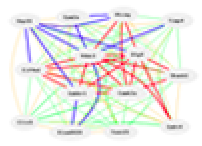|
Select and Search
______________________________________________________
Quick HELP Examples and
User's Guide
You can also use advanced commands. Copy these simple examples
into the Get Any or Combined search fields:
- POSITION=(chr1 25 30) finds genes, markers, or transcripts on chromosome 1 between 25 and 30 Mb.
- MEAN=(15 16) LRS=(23 46) in the Combined field finds highly expressed genes (15 to 16 log2 units) AND with peak LRS linkage between 23 and 46.
- RIF=mitochondrial searches RNA databases for GeneRIF links.
- WIKI=nicotine searches GeneWiki for genes that you or other users have annotated with the word nicotine.
- GO:0045202 searches for synapse-associated genes listed in the Gene Ontology.
- NAME=(watson jd) searches for all genes associated in PubMed with the author J D Watson.
- GO:0045202 LRS=(9 99 Chr4 122 155) cisLRS=(9 999 10)
in Combined finds synapse-associated genes with cis eQTL on Chr 4 from 122 and 155 Mb with LRS scores between 9 and 999.
- RIF=diabetes LRS=(9 999 Chr2 100 105) transLRS=(9 999 10)
in Combined finds diabetes-associated transcripts with peak trans eQTLs on Chr 2 between 100 and 105 Mb with LRS scores between 9 and 999.
|
Websites Affiliated with GeneNetwork
____________________________
Getting Started
- Select Species (or select All)
- Select Group (a specific sample)
- Select Type of data:
- Phenotype (traits)
- Genotype (markers)
- Expression (mRNAs)
- Select a Database
- Enter search terms in the Get Any or Combined field: words, genes, ID numbers, probes, advanced search commands
- Click on the Search button
- Optional: Use the Make Default button to save your preferences
____________________________
How to Use GeneNetwork
Take a 20-40 minute GeneNetwork Tour that includes screen shots and typical steps in the analysis.
For information about resources and methods, select the  buttons. buttons.
Review the Conditions and Contacts pages for information on the status of data sets and advice on their use and citation.
|
|

|
Web services initiated January, 1994 as Portable Dictionary of the Mouse Genome; June 15, 2001 as WebQTL; and Jan 5, 2005 as GeneNetwork.
This site is currently operated by
Rob Williams,
Pjotr Prins,
Zachary Sloan,
Arthur Centeno. Design and code by Pjotr Prins, Zach Sloan, Arthur Centeno, Danny Arends, Christian Fischer, Sam Ockman, Lei Yan, Xiaodong Zhou, Christian Fernandez, Ning Liu, Rudi Alberts, Elissa Chesler, Sujoy Roy, Evan G. Williams, Alexander G. Williams, Kenneth Manly, Jintao Wang, and Robert W. Williams, colleagues.
|

|

|
GeneNetwork support from:
- The UT Center for Integrative and Translational Genomics
- NIGMS Systems Genetics and Precision Medicine project (R01 GM123489, 2017-2021)
- NIDA NIDA Core Center of Excellence in Transcriptomics, Systems Genetics,
and the Addictome (P30 DA044223, 2017-2022)
- NIA Translational Systems Genetics of Mitochondria, Metabolism, and Aging (R01AG043930, 2013-2018)
- NIAAA Integrative Neuroscience Initiative on Alcoholism (U01 AA016662, U01 AA013499, U24 AA013513, U01 AA014425, 2006-2017)
- NIDA, NIMH, and NIAAA (P20-DA 21131, 2001-2012)
- NCI MMHCC (U01CA105417), NCRR, BIRN, (U24 RR021760)
|
|
It took 0.000 second(s) for tux01.uthsc.edu to generate this page
|
|







 buttons.
buttons.